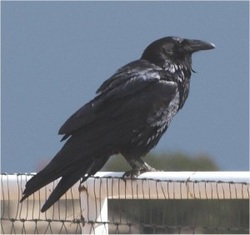Quonk! Quonk! Krnk! Santa Fe has both crows and ravens. The wheeling circuits of ravens in early Spring are joy to watch and their voices though anything but melodic are nonetheless intriguing. It puts in mind the older Italian-speaking nonnies of my youth, gabbling to each other in the kitchen with their scratchy voices.
Crows (Corvus brachyrhynchos) are widespread across North America and most folks are familiar with their “caw, caw”. They are glossy black, about 14-16″ long from tip to tail and they have acclimated well to living near humans. They are social and especially in Winter tend to aggregate in particular Santa Fe neighborhoods. Favorite roosts are large, winter-bare cottonwood trees which serve as lookouts from which a sentinel can survey the ground below, over walls and fences.
Crows (Corvus brachyrhynchos) are widespread across North America and most folks are familiar with their “caw, caw”. They are glossy black, about 14-16″ long from tip to tail and they have acclimated well to living near humans. They are social and especially in Winter tend to aggregate in particular Santa Fe neighborhoods. Favorite roosts are large, winter-bare cottonwood trees which serve as lookouts from which a sentinel can survey the ground below, over walls and fences.
 Common raven, Corvus corax
Common raven, Corvus corax Ravens (Corvus corax) are much larger (22-27″) with somewhat clunkier proportions and have much heavier beaks which can make short work of road-kill or garbage bags. In flight, their wedge shaped tail is often a better field mark than trying to judge size against nothing but blue sky.
This time of the year (early Spring), ravens are pairing off from their temporary Winter groups and getting ready for nesting. Ravens mate for life and reinforce their bonds through beautiful, almost playful courtship flights. And these are not the pre-programmed motions of other species like nighthawks, prairie chickens, or grebes. These wheeling, deliberate, give-and-take exchanges include pairs flying in either close formation or soaring in interlocking circles, dipping, or tipping upsidedown and calling. They play a graceful, 3D game of tag which changes as they move across the sky. Crows also pair-bond for life but, in contrast, may remain in extended family groups for several years with last year’s offspring helping to raise this year’s chicks.
This time of the year (early Spring), ravens are pairing off from their temporary Winter groups and getting ready for nesting. Ravens mate for life and reinforce their bonds through beautiful, almost playful courtship flights. And these are not the pre-programmed motions of other species like nighthawks, prairie chickens, or grebes. These wheeling, deliberate, give-and-take exchanges include pairs flying in either close formation or soaring in interlocking circles, dipping, or tipping upsidedown and calling. They play a graceful, 3D game of tag which changes as they move across the sky. Crows also pair-bond for life but, in contrast, may remain in extended family groups for several years with last year’s offspring helping to raise this year’s chicks.
 Raven in flight. Note the wedge-shaped tail.
Raven in flight. Note the wedge-shaped tail. Crows have been found to be particularly susceptible to West Nile Virus, a mosquito-borne disease from Africa which arrived in North America in 1999. West Nile Virus causes encephalitis in other animals including humans. Other corvid family species (like ravens, jays and magpies) are also affected, but apparently to lesser degrees. There are no known cases where direct transmission of WNV from crows to other species has occurred, but because crow populations may be affected earlier and more sensitively than other animals, they serve as an indicator species for outbreaks of the disease.
Both crows and ravens are omnivorous and will take a meal in whatever form is presented. Certainly our roadsides would be far less clean were it not for them picking up the roadkill, but they also enjoy fruit, insects, and seeds where they are available.
Barring some disease catastrophe, crows and ravens are fairly long-lived; ravens may live fifteen years in the wild and crows up to ten. In captivitiy, ravens have lived up to forty years.
And they are smart boy, are they smart. They are observant and consummate judges of potential threats, inventive puzzle-solvers and apparently have great communication skills. At some future time, I’ll devote a whole post to demonstrations of their intellectual capacity. Certainly when being watched by a raven, I have the sense of being sized up and sometimes falling short of whatever test they are applying.
Both crows and ravens are omnivorous and will take a meal in whatever form is presented. Certainly our roadsides would be far less clean were it not for them picking up the roadkill, but they also enjoy fruit, insects, and seeds where they are available.
Barring some disease catastrophe, crows and ravens are fairly long-lived; ravens may live fifteen years in the wild and crows up to ten. In captivitiy, ravens have lived up to forty years.
And they are smart boy, are they smart. They are observant and consummate judges of potential threats, inventive puzzle-solvers and apparently have great communication skills. At some future time, I’ll devote a whole post to demonstrations of their intellectual capacity. Certainly when being watched by a raven, I have the sense of being sized up and sometimes falling short of whatever test they are applying.


 RSS Feed
RSS Feed
